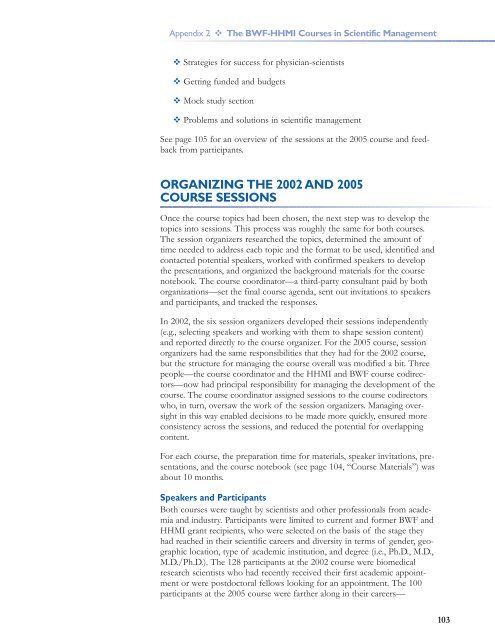Training Scientists to Make the Right Moves - Howard Hughes ...
Training Scientists to Make the Right Moves - Howard Hughes ...
Training Scientists to Make the Right Moves - Howard Hughes ...
Create successful ePaper yourself
Turn your PDF publications into a flip-book with our unique Google optimized e-Paper software.
Appendix 2 The BWF-HHMI Courses in Scientific Management<br />
Strategies for success for physician-scientists<br />
Getting funded and budgets<br />
Mock study section<br />
Problems and solutions in scientific management<br />
See page 105 for an overview of <strong>the</strong> sessions at <strong>the</strong> 2005 course and feedback<br />
from participants.<br />
ORGANIZING THE 2002 AND 2005<br />
COURSE SESSIONS<br />
Once <strong>the</strong> course <strong>to</strong>pics had been chosen, <strong>the</strong> next step was <strong>to</strong> develop <strong>the</strong><br />
<strong>to</strong>pics in<strong>to</strong> sessions. This process was roughly <strong>the</strong> same for both courses.<br />
The session organizers researched <strong>the</strong> <strong>to</strong>pics, determined <strong>the</strong> amount of<br />
time needed <strong>to</strong> address each <strong>to</strong>pic and <strong>the</strong> format <strong>to</strong> be used, identified and<br />
contacted potential speakers, worked with confirmed speakers <strong>to</strong> develop<br />
<strong>the</strong> presentations, and organized <strong>the</strong> background materials for <strong>the</strong> course<br />
notebook. The course coordina<strong>to</strong>r—a third-party consultant paid by both<br />
organizations—set <strong>the</strong> final course agenda, sent out invitations <strong>to</strong> speakers<br />
and participants, and tracked <strong>the</strong> responses.<br />
In 2002, <strong>the</strong> six session organizers developed <strong>the</strong>ir sessions independently<br />
(e.g., selecting speakers and working with <strong>the</strong>m <strong>to</strong> shape session content)<br />
and reported directly <strong>to</strong> <strong>the</strong> course organizer. For <strong>the</strong> 2005 course, session<br />
organizers had <strong>the</strong> same responsibilities that <strong>the</strong>y had for <strong>the</strong> 2002 course,<br />
but <strong>the</strong> structure for managing <strong>the</strong> course overall was modified a bit. Three<br />
people—<strong>the</strong> course coordina<strong>to</strong>r and <strong>the</strong> HHMI and BWF course codirec<strong>to</strong>rs—now<br />
had principal responsibility for managing <strong>the</strong> development of <strong>the</strong><br />
course. The course coordina<strong>to</strong>r assigned sessions <strong>to</strong> <strong>the</strong> course codirec<strong>to</strong>rs<br />
who, in turn, oversaw <strong>the</strong> work of <strong>the</strong> session organizers. Managing oversight<br />
in this way enabled decisions <strong>to</strong> be made more quickly, ensured more<br />
consistency across <strong>the</strong> sessions, and reduced <strong>the</strong> potential for overlapping<br />
content.<br />
For each course, <strong>the</strong> preparation time for materials, speaker invitations, presentations,<br />
and <strong>the</strong> course notebook (see page 104, “Course Materials”) was<br />
about 10 months.<br />
Speakers and Participants<br />
Both courses were taught by scientists and o<strong>the</strong>r professionals from academia<br />
and industry. Participants were limited <strong>to</strong> current and former BWF and<br />
HHMI grant recipients, who were selected on <strong>the</strong> basis of <strong>the</strong> stage <strong>the</strong>y<br />
had reached in <strong>the</strong>ir scientific careers and diversity in terms of gender, geographic<br />
location, type of academic institution, and degree (i.e., Ph.D., M.D.,<br />
M.D./Ph.D.). The 128 participants at <strong>the</strong> 2002 course were biomedical<br />
research scientists who had recently received <strong>the</strong>ir first academic appointment<br />
or were postdoc<strong>to</strong>ral fellows looking for an appointment. The 100<br />
participants at <strong>the</strong> 2005 course were far<strong>the</strong>r along in <strong>the</strong>ir careers—<br />
103
















